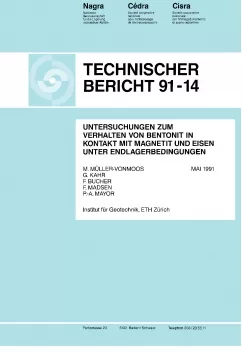
Technischer Bericht NTB 91-14
Untersuchungen zum Verhalten von Bentonit in Kontakt mit Magnetit und Eisen unter Endlagerbedingungen
The current Nagra concept for disposal of vitrified high-level radioactive waste foresees that the waste in the repository will be encapsulated in steel canisters surrounded by highly compacted bentonite. When the canister comes into contact with water which has been absorbed by the bentonite, the steel will corrode and magnetite and hydrogen will form.
This report presents the results of investigations into how magnetite and iron affect the swelling behaviour of the Nabentonite MX-80 and the Ca-bentonite Montigel. The experiments were conducted under conditions similar to those expected in a repository and covered cation exchange capacity, exchangeable cations and the swelling behaviour of the Na-bentonite MX-80 and the Ca-bentonite Montigel. Waste disposal is assumed to occur at a temperature of 80°C under an anoxic atmosphere (chiefly hydrogen gas). In addition to this, the behaviour of trivalent iron in the interlayer space of montmorillonite was investigated. For this purpose, the iron(III) form of the bentonites was manufactured. Before these experiments began, subsequent to the investigations of swelling behaviour and storage under assumed repository conditions, the interlayer charge, exchange capacity and exchangeable cations were determined. The investigations confirmed that contact between iron and bentonite under such conditions leads mainly to formation of magnetite and hydrogen. Montmorillonite does not take up iron by cation exchange, either on contact with magnetite or with iron itself. The trivalent iron is unstable in the interlayer space of the montmorillonite and is exchanged mainly for aluminium; no change in the interlayer charge can be determined in such a case. It is therefore to be assumed that the aluminium is taken up from the edges of the clay particles into the interlayer space, but that no chlorite formation can be observed during this process.
At 80°C and 150°C, the swelling pressures of the highly compacted bentonite-iron samples, related to the dry density of the bentonites, corresponded more or less to the swelling pressures of the untreated bentonites. The swelling pressure of the Fe(III)-bentonites was around 50 % higher. It is assumed that this is mainly due to the high hydration energy of the iron and aluminium ions.
